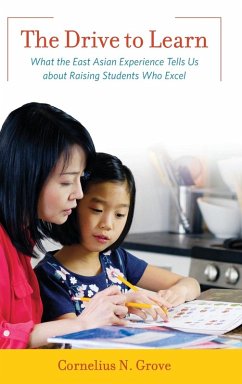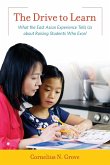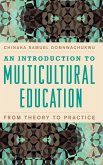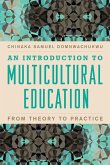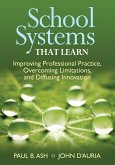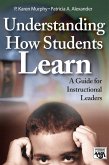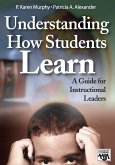Cornelius N. Grove
Drive to Learn
What the East Asian Experience Tells Us about Raising Students Who Excel
Cornelius N. Grove
Drive to Learn
What the East Asian Experience Tells Us about Raising Students Who Excel
- Gebundenes Buch
- Merkliste
- Auf die Merkliste
- Bewerten Bewerten
- Teilen
- Produkt teilen
- Produkterinnerung
- Produkterinnerung
The Drive to Learn helps American parents learn from how Chinese, Japanese, and Korean parents think about and carry out child-rearing and how it translates into education.
Andere Kunden interessierten sich auch für
![Drive to Learn Drive to Learn]() Cornelius N. GroveDrive to Learn36,99 €
Cornelius N. GroveDrive to Learn36,99 €![Introduction to Multicultural Education Introduction to Multicultural Education]() Chinaka S. DomnwachukwuIntroduction to Multicultural Education118,99 €
Chinaka S. DomnwachukwuIntroduction to Multicultural Education118,99 €![Introduction to Multicultural Education Introduction to Multicultural Education]() Chinaka S. DomnwachukwuIntroduction to Multicultural Education79,99 €
Chinaka S. DomnwachukwuIntroduction to Multicultural Education79,99 €![Around the World Search and Learn - Jamaica Around the World Search and Learn - Jamaica]() Valerie RainfordAround the World Search and Learn - Jamaica10,99 €
Valerie RainfordAround the World Search and Learn - Jamaica10,99 €![School Systems That Learn School Systems That Learn]() Paul B. AshSchool Systems That Learn35,99 €
Paul B. AshSchool Systems That Learn35,99 €![Understanding How Students Learn Understanding How Students Learn]() P. Karen MurphyUnderstanding How Students Learn67,99 €
P. Karen MurphyUnderstanding How Students Learn67,99 €![Understanding How Students Learn Understanding How Students Learn]() P. Karen MurphyUnderstanding How Students Learn30,99 €
P. Karen MurphyUnderstanding How Students Learn30,99 €-
-
-
The Drive to Learn helps American parents learn from how Chinese, Japanese, and Korean parents think about and carry out child-rearing and how it translates into education.
Produktdetails
- Produktdetails
- Verlag: Rowman & Littlefield Publishers
- Seitenzahl: 184
- Erscheinungstermin: 9. Juni 2017
- Englisch
- Abmessung: 235mm x 157mm x 15mm
- Gewicht: 426g
- ISBN-13: 9781475815092
- ISBN-10: 1475815093
- Artikelnr.: 47882127
- Herstellerkennzeichnung
- Libri GmbH
- Europaallee 1
- 36244 Bad Hersfeld
- gpsr@libri.de
- Verlag: Rowman & Littlefield Publishers
- Seitenzahl: 184
- Erscheinungstermin: 9. Juni 2017
- Englisch
- Abmessung: 235mm x 157mm x 15mm
- Gewicht: 426g
- ISBN-13: 9781475815092
- ISBN-10: 1475815093
- Artikelnr.: 47882127
- Herstellerkennzeichnung
- Libri GmbH
- Europaallee 1
- 36244 Bad Hersfeld
- gpsr@libri.de
Cornelius N. Grove is a former classroom teacher, he earned an Ed.D. at Columbia University, then taught Cross-Cultural Problems in Classroom Communication to graduate students there. A charter member of the International Academy of Intercultural Research, he is the author of entries on pedagogy across cultures in two encyclopedias as well as two recent books that reveal the cultural values that equip East Asian students to consistently outperform American students on PISA and other international comparative tests.
Preface
Why I Wrote This Book
How I Came to Write This Book
Receptive to Learning
Acknowledgements
Introduction
An Overview of How This Book Proceeds
The Plan of This Book
About This Book
Chapter 1: Daring to Seek Answers
The Question, Restated
The Parts of the Paradox
Reviewing Step 1 of the Discovery Process
Chapter 2: Evaluating Eyewitness Reports
Questioning Eyewitness Reports
Passiveness in Class
Rote Memorizing
How Step 2 Advanced Our Discovery Process
Chapter 3: Exploring Motivations
The Agony of Defeat
Why Motivations Differ
How Step 3 Advanced Our Discovery Process
Chapter 4: Analyzing Determination
From China to America
Deep Meanings of Learning
How Step 4 Advanced Our Discovery Process
Chapter 5: Assessing Emotional Drive
Self and Family
Mothers and Motivation
Self, Emotion, and Drive to Learn
How Step 5 Advanced Our Discovery Process
Chapter 6: Thinking Like a Sociologist
Learning in Different Societies
Learning to Be Competent; Learning in School
The Episode with the Key
How Step 6 Advanced Our Discovery Process
Chapter 7: Thinking Like a Historian
Taming Students in America
Taming Students in East Asia
Explaining East Asians' Drive to Learn
How Step 7 Advanced Our Discovery Process
Chapter 8: Revealing How Parents Think
The Outward Focus of the East Asian Family
Two Approaches to Raising Children
How the Chinese Talk about Parenting
How the Japanese Talk about Parenting
Cheerleaders and Coaches
How Step 8 Advanced Our Discovery Process
Chapter 9: Revealing What Parents Do
Maintain Very High Expectations.Consistently
Intervene to Insure that High Expectations are Met
A Revealing Study of Mothers and Children
How Step 9 Advanced Our Discovery Process
Chapter 10: So What Should We Do?
What Are Our Options?
So What Should Families Do?
Parenting with Guan: Seven Commitments to Your Child
Chapter 11: Responsibility and Creativity
Responsibility
Creativity
A Note About the Online Annotated Bibliography
Conclusion
Bibliography [standard, non-annotated]
Endnotes
Why I Wrote This Book
How I Came to Write This Book
Receptive to Learning
Acknowledgements
Introduction
An Overview of How This Book Proceeds
The Plan of This Book
About This Book
Chapter 1: Daring to Seek Answers
The Question, Restated
The Parts of the Paradox
Reviewing Step 1 of the Discovery Process
Chapter 2: Evaluating Eyewitness Reports
Questioning Eyewitness Reports
Passiveness in Class
Rote Memorizing
How Step 2 Advanced Our Discovery Process
Chapter 3: Exploring Motivations
The Agony of Defeat
Why Motivations Differ
How Step 3 Advanced Our Discovery Process
Chapter 4: Analyzing Determination
From China to America
Deep Meanings of Learning
How Step 4 Advanced Our Discovery Process
Chapter 5: Assessing Emotional Drive
Self and Family
Mothers and Motivation
Self, Emotion, and Drive to Learn
How Step 5 Advanced Our Discovery Process
Chapter 6: Thinking Like a Sociologist
Learning in Different Societies
Learning to Be Competent; Learning in School
The Episode with the Key
How Step 6 Advanced Our Discovery Process
Chapter 7: Thinking Like a Historian
Taming Students in America
Taming Students in East Asia
Explaining East Asians' Drive to Learn
How Step 7 Advanced Our Discovery Process
Chapter 8: Revealing How Parents Think
The Outward Focus of the East Asian Family
Two Approaches to Raising Children
How the Chinese Talk about Parenting
How the Japanese Talk about Parenting
Cheerleaders and Coaches
How Step 8 Advanced Our Discovery Process
Chapter 9: Revealing What Parents Do
Maintain Very High Expectations.Consistently
Intervene to Insure that High Expectations are Met
A Revealing Study of Mothers and Children
How Step 9 Advanced Our Discovery Process
Chapter 10: So What Should We Do?
What Are Our Options?
So What Should Families Do?
Parenting with Guan: Seven Commitments to Your Child
Chapter 11: Responsibility and Creativity
Responsibility
Creativity
A Note About the Online Annotated Bibliography
Conclusion
Bibliography [standard, non-annotated]
Endnotes
Preface
Why I Wrote This Book
How I Came to Write This Book
Receptive to Learning
Acknowledgements
Introduction
An Overview of How This Book Proceeds
The Plan of This Book
About This Book
Chapter 1: Daring to Seek Answers
The Question, Restated
The Parts of the Paradox
Reviewing Step 1 of the Discovery Process
Chapter 2: Evaluating Eyewitness Reports
Questioning Eyewitness Reports
Passiveness in Class
Rote Memorizing
How Step 2 Advanced Our Discovery Process
Chapter 3: Exploring Motivations
The Agony of Defeat
Why Motivations Differ
How Step 3 Advanced Our Discovery Process
Chapter 4: Analyzing Determination
From China to America
Deep Meanings of Learning
How Step 4 Advanced Our Discovery Process
Chapter 5: Assessing Emotional Drive
Self and Family
Mothers and Motivation
Self, Emotion, and Drive to Learn
How Step 5 Advanced Our Discovery Process
Chapter 6: Thinking Like a Sociologist
Learning in Different Societies
Learning to Be Competent; Learning in School
The Episode with the Key
How Step 6 Advanced Our Discovery Process
Chapter 7: Thinking Like a Historian
Taming Students in America
Taming Students in East Asia
Explaining East Asians' Drive to Learn
How Step 7 Advanced Our Discovery Process
Chapter 8: Revealing How Parents Think
The Outward Focus of the East Asian Family
Two Approaches to Raising Children
How the Chinese Talk about Parenting
How the Japanese Talk about Parenting
Cheerleaders and Coaches
How Step 8 Advanced Our Discovery Process
Chapter 9: Revealing What Parents Do
Maintain Very High Expectations.Consistently
Intervene to Insure that High Expectations are Met
A Revealing Study of Mothers and Children
How Step 9 Advanced Our Discovery Process
Chapter 10: So What Should We Do?
What Are Our Options?
So What Should Families Do?
Parenting with Guan: Seven Commitments to Your Child
Chapter 11: Responsibility and Creativity
Responsibility
Creativity
A Note About the Online Annotated Bibliography
Conclusion
Bibliography [standard, non-annotated]
Endnotes
Why I Wrote This Book
How I Came to Write This Book
Receptive to Learning
Acknowledgements
Introduction
An Overview of How This Book Proceeds
The Plan of This Book
About This Book
Chapter 1: Daring to Seek Answers
The Question, Restated
The Parts of the Paradox
Reviewing Step 1 of the Discovery Process
Chapter 2: Evaluating Eyewitness Reports
Questioning Eyewitness Reports
Passiveness in Class
Rote Memorizing
How Step 2 Advanced Our Discovery Process
Chapter 3: Exploring Motivations
The Agony of Defeat
Why Motivations Differ
How Step 3 Advanced Our Discovery Process
Chapter 4: Analyzing Determination
From China to America
Deep Meanings of Learning
How Step 4 Advanced Our Discovery Process
Chapter 5: Assessing Emotional Drive
Self and Family
Mothers and Motivation
Self, Emotion, and Drive to Learn
How Step 5 Advanced Our Discovery Process
Chapter 6: Thinking Like a Sociologist
Learning in Different Societies
Learning to Be Competent; Learning in School
The Episode with the Key
How Step 6 Advanced Our Discovery Process
Chapter 7: Thinking Like a Historian
Taming Students in America
Taming Students in East Asia
Explaining East Asians' Drive to Learn
How Step 7 Advanced Our Discovery Process
Chapter 8: Revealing How Parents Think
The Outward Focus of the East Asian Family
Two Approaches to Raising Children
How the Chinese Talk about Parenting
How the Japanese Talk about Parenting
Cheerleaders and Coaches
How Step 8 Advanced Our Discovery Process
Chapter 9: Revealing What Parents Do
Maintain Very High Expectations.Consistently
Intervene to Insure that High Expectations are Met
A Revealing Study of Mothers and Children
How Step 9 Advanced Our Discovery Process
Chapter 10: So What Should We Do?
What Are Our Options?
So What Should Families Do?
Parenting with Guan: Seven Commitments to Your Child
Chapter 11: Responsibility and Creativity
Responsibility
Creativity
A Note About the Online Annotated Bibliography
Conclusion
Bibliography [standard, non-annotated]
Endnotes

